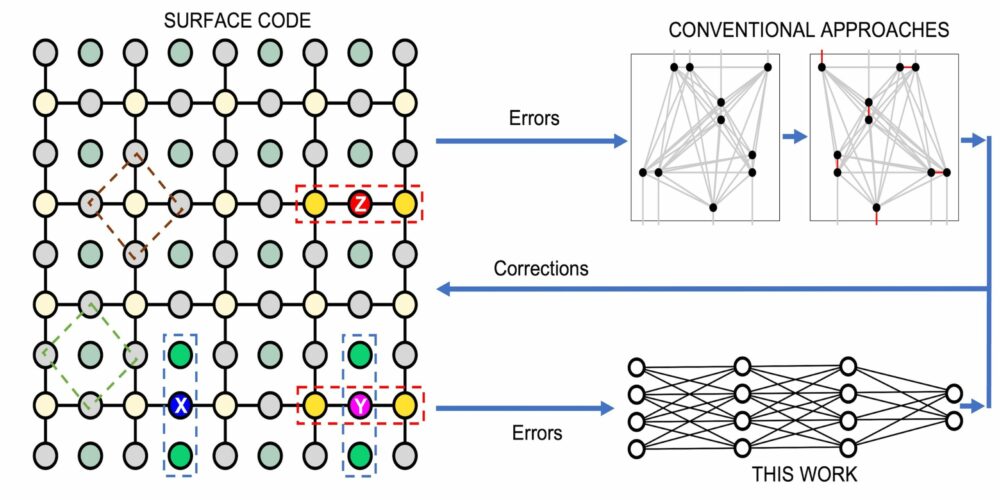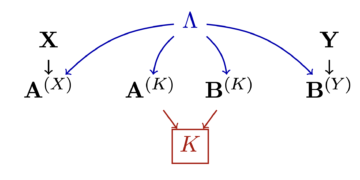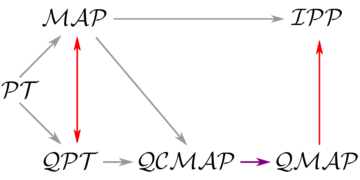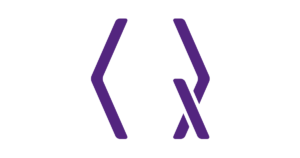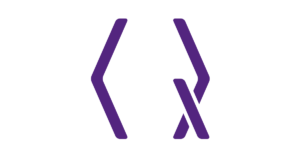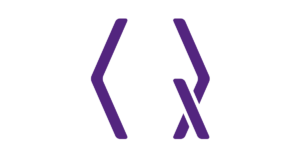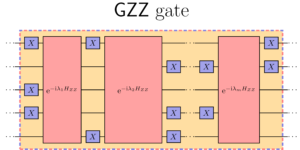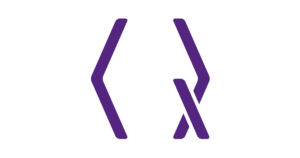1Center for Quantum Computation and Communication Technology, School of Physics, University of Melbourne, Parkville, 3010, VIC, Australia.
2School of Computing and Information Systems, Melbourne School of Engineering, University of Melbourne, Parkville, 3010, VIC, Australia
3Data61, CSIRO, Clayton, 3168, VIC, Australia
Find this paper interesting or want to discuss? Scite or leave a comment on SciRate.
Abstract
Surface code error correction offers a highly promising pathway to achieve scalable fault-tolerant quantum computing. When operated as stabilizer codes, surface code computations consist of a syndrome decoding step where measured stabilizer operators are used to determine appropriate corrections for errors in physical qubits. Decoding algorithms have undergone substantial development, with recent work incorporating machine learning (ML) techniques. Despite promising initial results, the ML-based syndrome decoders are still limited to small scale demonstrations with low latency and are incapable of handling surface codes with boundary conditions and various shapes needed for lattice surgery and braiding. Here, we report the development of an artificial neural network (ANN) based scalable and fast syndrome decoder capable of decoding surface codes of arbitrary shape and size with data qubits suffering from the depolarizing error model. Based on rigorous training over 50 million random quantum error instances, our ANN decoder is shown to work with code distances exceeding 1000 (more than 4 million physical qubits), which is the largest ML-based decoder demonstration to-date. The established ANN decoder demonstrates an execution time in principle independent of code distance, implying that its implementation on dedicated hardware could potentially offer surface code decoding times of O($mu$sec), commensurate with the experimentally realisable qubit coherence times. With the anticipated scale-up of quantum processors within the next decade, their augmentation with a fast and scalable syndrome decoder such as developed in our work is expected to play a decisive role towards experimental implementation of fault-tolerant quantum information processing.
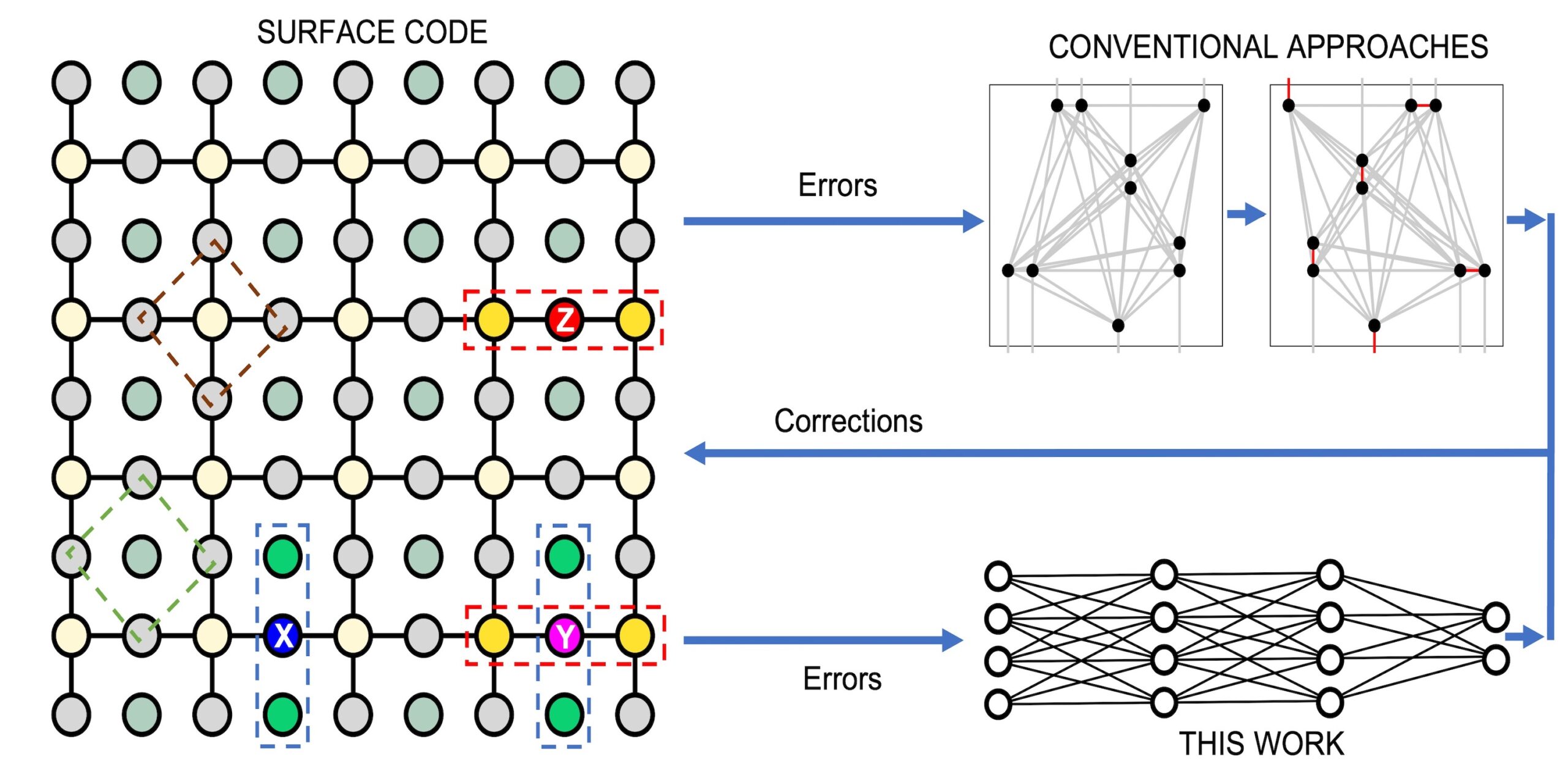
Featured image: Artificial neural network decoder framework for fast and scalable error correction.
Popular summary
Our work proposed and implemented a novel convolutional neural network framework to address the scaling problems encountered when decoding large distance surface codes. The convolutional neural network was given an input comprised of changed parity measurements, as well as the boundary structure of the error correction code. Given the finite window of local observation occurring throughout the convolutional neural network, a mop-up decoder was used to correct any sparse residual errors that may remain. Based on rigorous training over 50 million random quantum error instances, our decoder was shown to work with code distances exceeding 1000 (more than 4 million physical qubits), which was the largest ML-based decoder demonstration to-date.
The use of convolutional neural networks and boundary structure in the input allowed our network to be applied on a wide range of surface code distances and boundary configurations. The local connectivity of the network allows low latency to be retained when decoding larger distance codes and readily facilitates parallelization. Our work addresses a key problem in the use of neural networks for decoding at scales of problems of practical interest and allows further research involving the use of networks with similar structure.
► BibTeX data
► References
[1] S. Pirandola, U. L. Andersen, L. Banchi, M. Berta, D. Bunandar, R. Colbeck, D. Englund, T. Gehring, C. Lupo, C. Ottaviani, J. L. Pereira, M. Razavi, J. Shamsul Shaari, M. Tomamichel, V. C. Usenko, G. Vallone, P. Villoresi, and P. Wallden. “Advances in quantum cryptography”. Adv. Opt. Photon. 12, 1012–1236 (2020).
https://doi.org/10.1364/AOP.361502
[2] Yudong Cao, Jonathan Romero, Jonathan P. Olson, Matthias Degroote, Peter D. Johnson, Mária Kieferová, Ian D. Kivlichan, Tim Menke, Borja Peropadre, Nicolas P. D. Sawaya, Sukin Sim, Libor Veis, and Alán Aspuru-Guzik. “Quantum chemistry in the age of quantum computing”. Chemical Reviews 119, 10856–10915 (2019).
https://doi.org/10.1021/acs.chemrev.8b00803
[3] Román Orús, Samuel Mugel, and Enrique Lizaso. “Quantum computing for finance: Overview and prospects”. Reviews in Physics 4, 100028 (2019).
https://doi.org/10.1016/j.revip.2019.100028
[4] Craig Gidney and Martin Ekerå. “How to factor 2048 bit RSA integers in 8 hours using 20 million noisy qubits”. Quantum 5, 433 (2021).
https://doi.org/10.22331/q-2021-04-15-433
[5] Joonho Lee, Dominic W. Berry, Craig Gidney, William J. Huggins, Jarrod R. McClean, Nathan Wiebe, and Ryan Babbush. “Even more efficient quantum computations of chemistry through tensor hypercontraction”. PRX Quantum 2, 030305 (2021).
https://doi.org/10.1103/PRXQuantum.2.030305
[6] Yuval R. Sanders, Dominic W. Berry, Pedro C.S. Costa, Louis W. Tessler, Nathan Wiebe, Craig Gidney, Hartmut Neven, and Ryan Babbush. “Compilation of fault-tolerant quantum heuristics for combinatorial optimization”. PRX Quantum 1, 020312 (2020).
https://doi.org/10.1103/PRXQuantum.1.020312
[7] Eric Dennis, Alexei Kitaev, Andrew Landahl, and John Preskill. “Topological quantum memory”. Journal of Mathematical Physics 43, 4452–4505 (2002).
https://doi.org/10.1063/1.1499754
[8] Christian Kraglund Andersen, Ants Remm, Stefania Lazar, Sebastian Krinner, Nathan Lacroix, Graham J. Norris, Mihai Gabureac, Christopher Eichler, and Andreas Wallraff. “Repeated quantum error detection in a surface code”. Nature Physics 16, 875–880 (2020).
https://doi.org/10.1038/s41567-020-0920-y
[9] Zijun Chen, Kevin J Satzinger, Juan Atalaya, Alexander N Korotkov, Andrew Dunsworth, Daniel Sank, Chris Quintana, Matt McEwen, Rami Barends, Paul V Klimov, et al. “Exponential suppression of bit or phase errors with cyclic error correction”. Nature 595, 383–387 (2021).
https://doi.org/10.1038/s41586-021-03588-y
[10] Austin G. Fowler, David S. Wang, and Lloyd C. L. Hollenberg. “Surface code quantum error correction incorporating accurate error propagation” (2010). arXiv:1004.0255.
https://doi.org/10.48550/arXiv.1004.0255
arXiv:1004.0255
[11] Austin G. Fowler, Adam C. Whiteside, and Lloyd C. L. Hollenberg. “Towards practical classical processing for the surface code”. Physical Review Letters 108 (2012).
https://doi.org/10.1103/physrevlett.108.180501
[12] Austin G. Fowler. “Optimal complexity correction of correlated errors in the surface code” (2013). arXiv:1310.0863.
https://doi.org/10.48550/arXiv.1310.0863
arXiv:1310.0863
[13] Fern H. E. Watson, Hussain Anwar, and Dan E. Browne. “Fast fault-tolerant decoder for qubit and qudit surface codes”. Phys. Rev. A 92, 032309 (2015).
https://doi.org/10.1103/PhysRevA.92.032309
[14] Guillaume Duclos-Cianci and David Poulin. “Fast decoders for topological quantum codes”. Phys. Rev. Lett. 104, 050504 (2010).
https://doi.org/10.1103/PhysRevLett.104.050504
[15] Robert Raussendorf and Jim Harrington. “Fault-tolerant quantum computation with high threshold in two dimensions”. Phys. Rev. Lett. 98, 190504 (2007).
https://doi.org/10.1103/PhysRevLett.98.190504
[16] Daniel Litinski. “A game of surface codes: Large-scale quantum computing with lattice surgery”. Quantum 3, 128 (2019).
https://doi.org/10.22331/q-2019-03-05-128
[17] Savvas Varsamopoulos, Ben Criger, and Koen Bertels. “Decoding small surface codes with feedforward neural networks”. Quantum Science and Technology 3, 015004 (2017).
https://doi.org/10.1088/2058-9565/aa955a
[18] Amarsanaa Davaasuren, Yasunari Suzuki, Keisuke Fujii, and Masato Koashi. “General framework for constructing fast and near-optimal machine-learning-based decoder of the topological stabilizer codes”. Phys. Rev. Res. 2, 033399 (2020).
https://doi.org/10.1103/PhysRevResearch.2.033399
[19] Giacomo Torlai and Roger G. Melko. “Neural decoder for topological codes”. Phys. Rev. Lett. 119, 030501 (2017).
https://doi.org/10.1103/PhysRevLett.119.030501
[20] Stefan Krastanov and Liang Jiang. “Deep neural network probabilistic decoder for stabilizer codes”. Scientific Reports 7 (2017).
https://doi.org/10.1038/s41598-017-11266-1
[21] Paul Baireuther, Thomas E. O’Brien, Brian Tarasinski, and Carlo W. J. Beenakker. “Machine-learning-assisted correction of correlated qubit errors in a topological code”. Quantum 2, 48 (2018).
https://doi.org/10.22331/q-2018-01-29-48
[22] Debasmita Bhoumik, Pinaki Sen, Ritajit Majumdar, Susmita Sur-Kolay, Latesh Kumar K J, and Sundaraja Sitharama Iyengar. “Efficient decoding of surface code syndromes for error correction in quantum computing” (2021). arXiv:2110.10896.
https://doi.org/10.48550/arXiv.2110.10896
arXiv:2110.10896
[23] Ryan Sweke, Markus S Kesselring, Evert P L van Nieuwenburg, and Jens Eisert. “Reinforcement learning decoders for fault-tolerant quantum computation”. Machine Learning: Science and Technology 2, 025005 (2020).
https://doi.org/10.1088/2632-2153/abc609
[24] Elisha Siddiqui Matekole, Esther Ye, Ramya Iyer, and Samuel Yen-Chi Chen. “Decoding surface codes with deep reinforcement learning and probabilistic policy reuse” (2022). arXiv:2212.11890.
https://doi.org/10.48550/arXiv.2212.11890
arXiv:2212.11890
[25] Ramon W. J. Overwater, Masoud Babaie, and Fabio Sebastiano. “Neural-network decoders for quantum error correction using surface codes: A space exploration of the hardware cost-performance tradeoffs”. IEEE Transactions on Quantum Engineering 3, 1–19 (2022).
https://doi.org/10.1109/TQE.2022.3174017
[26] Kai Meinerz, Chae-Yeun Park, and Simon Trebst. “Scalable neural decoder for topological surface codes”. Phys. Rev. Lett. 128, 080505 (2022).
https://doi.org/10.1103/PhysRevLett.128.080505
[27] S. Varsamopoulos, K. Bertels, and C. Almudever. “Comparing neural network based decoders for the surface code”. IEEE Transactions on Computers 69, 300–311 (2020).
https://doi.org/10.1109/TC.2019.2948612
[28] Oscar Higgott. “Pymatching: A python package for decoding quantum codes with minimum-weight perfect matching” (2021). arXiv:2105.13082.
https://doi.org/10.48550/arXiv.2105.13082
arXiv:2105.13082
[29] Christopher Chamberland and Pooya Ronagh. “Deep neural decoders for near term fault-tolerant experiments”. Quantum Science and Technology 3, 044002 (2018).
https://doi.org/10.1088/2058-9565/aad1f7
[30] Daniel Gottesman. “Stabilizer codes and quantum error correction” (1997). arXiv:quant-ph/9705052.
https://doi.org/10.48550/arXiv.quant-ph/9705052
arXiv:quant-ph/9705052
[31] Charles D. Hill, Eldad Peretz, Samuel J. Hile, Matthew G. House, Martin Fuechsle, Sven Rogge, Michelle Y. Simmons, and Lloyd C. L. Hollenberg. “A surface code quantum computer in silicon”. Science Advances 1, e1500707 (2015).
https://doi.org/10.1126/sciadv.1500707
[32] G. Pica, B. W. Lovett, R. N. Bhatt, T. Schenkel, and S. A. Lyon. “Surface code architecture for donors and dots in silicon with imprecise and nonuniform qubit couplings”. Phys. Rev. B 93, 035306 (2016).
https://doi.org/10.1103/PhysRevB.93.035306
[33] Charles D. Hill, Muhammad Usman, and Lloyd C. L. Hollenberg. “An exchange-based surface-code quantum computer architecture in silicon” (2021). arXiv:2107.11981.
https://doi.org/10.48550/arXiv.2107.11981
arXiv:2107.11981
[34] Christopher Chamberland, Guanyu Zhu, Theodore J. Yoder, Jared B. Hertzberg, and Andrew W. Cross. “Topological and subsystem codes on low-degree graphs with flag qubits”. Phys. Rev. X 10, 011022 (2020).
https://doi.org/10.1103/PhysRevX.10.011022
[35] H. Bombin, Ruben S. Andrist, Masayuki Ohzeki, Helmut G. Katzgraber, and M. A. Martin-Delgado. “Strong resilience of topological codes to depolarization”. Phys. Rev. X 2, 021004 (2012).
https://doi.org/10.1103/PhysRevX.2.021004
[36] Ashley M. Stephens. “Fault-tolerant thresholds for quantum error correction with the surface code”. Phys. Rev. A 89, 022321 (2014).
https://doi.org/10.1103/PhysRevA.89.022321
[37] David S. Wang, Austin G. Fowler, and Lloyd C. L. Hollenberg. “Surface code quantum computing with error rates over 1%”. Phys. Rev. A 83, 020302 (2011).
https://doi.org/10.1103/PhysRevA.83.020302
[38] Austin G. Fowler and Craig Gidney. “Low overhead quantum computation using lattice surgery” (2019). arXiv:1808.06709.
https://doi.org/10.48550/arXiv.1808.06709
arXiv:1808.06709
[39] Austin G. Fowler, Matteo Mariantoni, John M. Martinis, and Andrew N. Cleland. “Surface codes: Towards practical large-scale quantum computation”. Physical Review A 86 (2012).
https://doi.org/10.1103/physreva.86.032324
[40] Xiaotong Ni. “Neural network decoders for large-distance 2d toric codes”. Quantum 4, 310 (2020).
https://doi.org/10.22331/q-2020-08-24-310
[41] A. Holmes, M. Jokar, G. Pasandi, Y. Ding, M. Pedram, and F. T. Chong. “Nisq+: Boosting quantum computing power by approximating quantum error correction”. In 2020 ACM/IEEE 47th Annual International Symposium on Computer Architecture (ISCA). Pages 556–569. Los Alamitos, CA, USA (2020). IEEE Computer Society.
https://doi.org/10.1109/ISCA45697.2020.00053
[42] Christian Kraglund Andersen, Ants Remm, Stefania Lazar, Sebastian Krinner, Johannes Heinsoo, Jean-Claude Besse, Mihai Gabureac, Andreas Wallraff, and Christopher Eichler. “Entanglement stabilization using ancilla-based parity detection and real-time feedback in superconducting circuits”. npj Quantum Information 5 (2019).
https://doi.org/10.1038/s41534-019-0185-4
[43] Martín Abadi, Ashish Agarwal, Paul Barham, Eugene Brevdo, Zhifeng Chen, Craig Citro, Greg S. Corrado, Andy Davis, Jeffrey Dean, Matthieu Devin, Sanjay Ghemawat, Ian Goodfellow, Andrew Harp, Geoffrey Irving, Michael Isard, Yangqing Jia, Rafal Jozefowicz, Lukasz Kaiser, Manjunath Kudlur, Josh Levenberg, Dan Mane, Rajat Monga, Sherry Moore, Derek Murray, Chris Olah, Mike Schuster, Jonathon Shlens, Benoit Steiner, Ilya Sutskever, Kunal Talwar, Paul Tucker, Vincent Vanhoucke, Vijay Vasudevan, Fernanda Viegas, Oriol Vinyals, Pete Warden, Martin Wattenberg, Martin Wicke, Yuan Yu, and Xiaoqiang Zheng. “Tensorflow: Large-scale machine learning on heterogeneous distributed systems” (2016). arXiv:1603.04467.
https://doi.org/10.48550/arXiv.1603.04467
arXiv:1603.04467
[44] Nicolas Delfosse and Naomi H. Nickerson. “Almost-linear time decoding algorithm for topological codes”. Quantum 5, 595 (2021).
https://doi.org/10.22331/q-2021-12-02-595
[45] Takashi Kobayashi, Joseph Salfi, Cassandra Chua, Joost van der Heijden, Matthew G. House, Dimitrie Culcer, Wayne D. Hutchison, Brett C. Johnson, Jeff C. McCallum, Helge Riemann, Nikolay V. Abrosimov, Peter Becker, Hans-Joachim Pohl, Michelle Y. Simmons, and Sven Rogge. “Engineering long spin coherence times of spin–orbit qubits in silicon”. Nature Materials 20, 38–42 (2020).
https://doi.org/10.1038/s41563-020-0743-3
[46] J. Pablo Bonilla Ataides, David K. Tuckett, Stephen D. Bartlett, Steven T. Flammia, and Benjamin J. Brown. “The XZZX surface code”. Nature Communications 12 (2021).
https://doi.org/10.1038/s41467-021-22274-1
[47] Dmitri E. Nikonov and Ian A. Young. “Benchmarking delay and energy of neural inference circuits”. IEEE Journal on Exploratory Solid-State Computational Devices and Circuits 5, 75–84 (2019).
https://doi.org/10.1109/JXCDC.2019.2956112
[48] Austin G. Fowler. “Minimum weight perfect matching of fault-tolerant topological quantum error correction in average $o(1)$ parallel time” (2014). arXiv:1307.1740.
https://doi.org/10.48550/arXiv.1307.1740
arXiv:1307.1740
[49] Vedran Dunjko and Hans J Briegel. “Machine learning & artificial intelligence in the quantum domain: a review of recent progress”. Reports on Progress in Physics 81, 074001 (2018).
https://doi.org/10.1088/1361-6633/aab406
[50] Laia Domingo Colomer, Michalis Skotiniotis, and Ramon Muñoz-Tapia. “Reinforcement learning for optimal error correction of toric codes”. Physics Letters A 384, 126353 (2020).
https://doi.org/10.1016/j.physleta.2020.126353
[51] Milap Sheth, Sara Zafar Jafarzadeh, and Vlad Gheorghiu. “Neural ensemble decoding for topological quantum error-correcting codes”. Phys. Rev. A 101, 032338 (2020).
https://doi.org/10.1103/PhysRevA.101.032338
[52] David Fitzek, Mattias Eliasson, Anton Frisk Kockum, and Mats Granath. “Deep q-learning decoder for depolarizing noise on the toric code”. Phys. Rev. Res. 2, 023230 (2020).
https://doi.org/10.1103/PhysRevResearch.2.023230
[53] Savvas Varsamopoulos, Koen Bertels, and Carmen G Almudever. “Decoding surface code with a distributed neural network–based decoder”. Quantum Machine Intelligence 2, 1–12 (2020).
https://doi.org/10.1007/s42484-020-00015-9
[54] Thomas Wagner, Hermann Kampermann, and Dagmar Bruß. “Symmetries for a high-level neural decoder on the toric code”. Phys. Rev. A 102, 042411 (2020).
https://doi.org/10.1103/PhysRevA.102.042411
[55] Philip Andreasson, Joel Johansson, Simon Liljestrand, and Mats Granath. “Quantum error correction for the toric code using deep reinforcement learning”. Quantum 3, 183 (2019).
https://doi.org/10.22331/q-2019-09-02-183
[56] Nikolas P. Breuckmann and Xiaotong Ni. “Scalable neural network decoders for higher dimensional quantum codes”. Quantum 2, 68 (2018).
https://doi.org/10.22331/q-2018-05-24-68
Cited by
[1] Christopher Chamberland, Luis Goncalves, Prasahnt Sivarajah, Eric Peterson, and Sebastian Grimberg, “Techniques for combining fast local decoders with global decoders under circuit-level noise”, arXiv:2208.01178, (2022).
[2] Samuel C. Smith, Benjamin J. Brown, and Stephen D. Bartlett, “Local Predecoder to Reduce the Bandwidth and Latency of Quantum Error Correction”, Physical Review Applied 19 3, 034050 (2023).
[3] Xinyu Tan, Fang Zhang, Rui Chao, Yaoyun Shi, and Jianxin Chen, “Scalable surface code decoders with parallelization in time”, arXiv:2209.09219, (2022).
[4] Maxwell T. West, Sarah M. Erfani, Christopher Leckie, Martin Sevior, Lloyd C. L. Hollenberg, and Muhammad Usman, “Benchmarking adversarially robust quantum machine learning at scale”, Physical Review Research 5 2, 023186 (2023).
[5] Yosuke Ueno, Masaaki Kondo, Masamitsu Tanaka, Yasunari Suzuki, and Yutaka Tabuchi, “NEO-QEC: Neural Network Enhanced Online Superconducting Decoder for Surface Codes”, arXiv:2208.05758, (2022).
[6] Mengyu Zhang, Xiangyu Ren, Guanglei Xi, Zhenxing Zhang, Qiaonian Yu, Fuming Liu, Hualiang Zhang, Shengyu Zhang, and Yi-Cong Zheng, “A Scalable, Fast and Programmable Neural Decoder for Fault-Tolerant Quantum Computation Using Surface Codes”, arXiv:2305.15767, (2023).
[7] Karl Hammar, Alexei Orekhov, Patrik Wallin Hybelius, Anna Katariina Wisakanto, Basudha Srivastava, Anton Frisk Kockum, and Mats Granath, “Error-rate-agnostic decoding of topological stabilizer codes”, Physical Review A 105 4, 042616 (2022).
[8] Maxwell T. West and Muhammad Usman, “Framework for Donor-Qubit Spatial Metrology in Silicon with Depths Approaching the Bulk Limit”, Physical Review Applied 17 2, 024070 (2022).
[9] Maxwell T. West, Shu-Lok Tsang, Jia S. Low, Charles D. Hill, Christopher Leckie, Lloyd C. L. Hollenberg, Sarah M. Erfani, and Muhammad Usman, “Towards quantum enhanced adversarial robustness in machine learning”, arXiv:2306.12688, (2023).
[10] Moritz Lange, Pontus Havström, Basudha Srivastava, Valdemar Bergentall, Karl Hammar, Olivia Heuts, Evert van Nieuwenburg, and Mats Granath, “Data-driven decoding of quantum error correcting codes using graph neural networks”, arXiv:2307.01241, (2023).
The above citations are from SAO/NASA ADS (last updated successfully 2023-07-12 14:31:13). The list may be incomplete as not all publishers provide suitable and complete citation data.
Could not fetch Crossref cited-by data during last attempt 2023-07-12 14:31:11: Could not fetch cited-by data for 10.22331/q-2023-07-12-1058 from Crossref. This is normal if the DOI was registered recently.
This Paper is published in Quantum under the Creative Commons Attribution 4.0 International (CC BY 4.0) license. Copyright remains with the original copyright holders such as the authors or their institutions.
- SEO Powered Content & PR Distribution. Get Amplified Today.
- PlatoData.Network Vertical Generative Ai. Empower Yourself. Access Here.
- PlatoAiStream. Web3 Intelligence. Knowledge Amplified. Access Here.
- PlatoESG. Automotive / EVs, Carbon, CleanTech, Energy, Environment, Solar, Waste Management. Access Here.
- BlockOffsets. Modernizing Environmental Offset Ownership. Access Here.
- Source: https://quantum-journal.org/papers/q-2023-07-12-1058/
- :has
- :is
- :not
- :where
- ][p
- 1
- 10
- 11
- 12
- 13
- 14
- 15%
- 16
- 17
- 19
- 20
- 2011
- 2012
- 2013
- 2014
- 2015
- 2016
- 2017
- 2018
- 2019
- 2020
- 2021
- 2022
- 2023
- 22
- 23
- 24
- 25
- 26%
- 27
- 28
- 2D
- 30
- 31
- 32
- 33
- 36
- 39
- 40
- 49
- 50
- 51
- 7
- 8
- 9
- 98
- a
- above
- ABSTRACT
- access
- accuracy
- accurate
- Achieve
- achieved
- across
- active
- Adam
- address
- addresses
- advances
- adversarial
- affiliations
- age
- AL
- Alexander
- algorithm
- algorithms
- All
- allowed
- allows
- also
- an
- and
- Andrew
- annual
- Anticipated
- any
- applied
- approaching
- appropriate
- architecture
- ARE
- artificial
- artificial intelligence
- AS
- At
- austin
- Australia
- author
- authors
- average
- Bandwidth
- based
- BE
- being
- ben
- benchmarking
- Benjamin
- Bit
- boosting
- boundary
- Break
- Brian
- by
- CA
- calculate
- CAN
- capable
- caused
- changed
- Charles
- chemical
- chemistry
- chen
- chong
- Chris
- Christopher
- code
- codes
- combining
- comment
- Commons
- Communication
- Communications
- complete
- complexity
- Comprised
- computation
- computations
- computer
- computers
- computing
- computing power
- conditions
- Connectivity
- constructing
- copyright
- correct
- Corrections
- could
- Craig
- Cross
- crucial
- cryptography
- Current
- Daniel
- data
- data-driven
- David
- Davis
- decade
- decisive
- Decoding
- dedicated
- deep
- delay
- demonstrates
- deployed
- Depths
- Derek
- Despite
- detect
- Detection
- Determine
- developed
- Development
- Devices
- dimensions
- directly
- discuss
- distance
- distributed
- distributed systems
- domain
- done
- during
- e
- E&T
- effectively
- efficient
- energy
- Engineering
- enhanced
- enough
- error
- Errors
- established
- eugene
- exceeding
- execution
- expected
- experiments
- exploration
- facilitates
- factor
- FAST
- feedback
- finance
- For
- Framework
- from
- further
- game
- generation
- given
- Global
- graph
- graphs
- Handling
- Hardware
- harvard
- Have
- here
- High
- high-level
- higher
- highly
- holders
- HOURS
- House
- HTTPS
- IEEE
- if
- image
- implementation
- implemented
- in
- incapable
- incorporating
- independent
- information
- Information Systems
- initial
- input
- institutions
- Intelligence
- interest
- interesting
- International
- investigating
- involving
- ITS
- JavaScript
- jeffrey
- Jim
- John
- Johnson
- journal
- jpg
- karl
- Key
- large
- large-scale
- larger
- largest
- Last
- Latency
- learning
- Leave
- Lee
- License
- LIMIT
- Limited
- List
- local
- logical
- Long
- looked
- los
- Louis
- Low
- machine
- machine learning
- Martin
- matching
- materials
- mathematical
- matthew
- max-width
- Maxwell
- May..
- mcclean
- measurements
- Melbourne
- Memory
- Metrology
- Michael
- mike
- million
- minimum
- ML
- model
- Month
- more
- more efficient
- Murray
- Nature
- Near
- Need
- needed
- needs
- network
- networks
- neural network
- neural networks
- next
- Nicolas
- Noise
- normal
- novel
- occurring
- of
- offer
- Offers
- on
- online
- open
- operated
- operators
- optimal
- optimization
- or
- order
- original
- our
- over
- overview
- Pace
- package
- pages
- Paper
- Parallel
- parity
- Park
- pathway
- Paul
- perfect
- Peter
- Peterson
- phase
- physical
- Physics
- plato
- Plato Data Intelligence
- PlatoData
- Play
- policy
- potentially
- power
- Practical
- previous
- primarily
- principle
- Problem
- problems
- processing
- processors
- Progress
- promising
- proposed
- prospects
- provide
- published
- publisher
- publishers
- Python
- Quantum
- Quantum Computer
- quantum computing
- quantum cryptography
- quantum error correction
- quantum information
- quantum machine learning
- Qubit
- qubits
- RAMI
- random
- range
- rapid
- Rates
- real-time
- recent
- recently
- reduce
- references
- registered
- remain
- remains
- ren
- report
- Reports
- research
- resilience
- Results
- reuse
- review
- Reviews
- rigorous
- ROBERT
- robust
- robustness
- Role
- rsa
- Ryan
- s
- sanders
- scalable
- Scale
- scale-up
- scales
- scaling
- schemes
- School
- School of Engineering
- Science
- Science and Technology
- scientific
- Shape
- shapes
- shown
- Silicon
- SIM
- similar
- Simon
- simultaneously
- Size
- small
- Society
- SOLVE
- some
- Space
- Spatial
- Spin
- Step
- Stephen
- steven
- Still
- structure
- substantial
- Successfully
- such
- suffering
- Suffers
- suitable
- superconducting
- suppression
- Surface
- Surgery
- Symposium
- Systems
- Task
- techniques
- Technology
- term
- than
- that
- The
- their
- this
- threshold
- Through
- throughout
- Tim
- time
- times
- Title
- to
- topological quantum
- towards
- Training
- Transactions
- two
- under
- undergone
- underlying
- university
- updated
- URL
- USA
- use
- used
- uses
- using
- various
- vincent
- vlad
- volume
- W
- want
- was
- Watson
- we
- weight
- WELL
- West
- when
- which
- wide
- Wide range
- window
- with
- within
- Work
- X
- xi
- Ye
- year
- young
- Yuan
- zephyrnet

